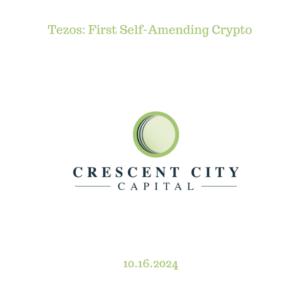Tezos: First Self-Amending Crypto
By Selene Wang | Crescent City Capital Market Analyst Intern
1. Introduction to Tezos
Tezos was created as a cryptocurrency that allows anyone who owns its XTZ token to vote on any future changes to network rules. Once the consensus has been reached for these rule changes, the software automatically updates the rules across all network nodes. This essentially puts the power of directing the future of Tezos directly into its users’ hands.
One of the main differences between Tezos and other cryptocurrencies is the fact that it is both decentralized and self-governing. Its automatic upgrades and updates also play a major role in the uniqueness of Tezos. The network participants can easily vote for or against the proposed updates, thus making it the perfect place for crypto enthusiasts.
Adopting this system of governance provides the network with the benefit of vastly increased user satisfaction – which also nearly eliminates the chances of a hard fork occurring.
The arrival of Tezos was groundbreaking, as its new model separated cryptocurrencies into two camps, those with “on-chain governance” and those with “off-chain governance.” (Tezos uses on-chain governance.)
2. How does it work
While Tezos offers similar features to other cryptocurrencies, its system of operations is much different. Tezos’ blockchain can be split into two distinct parts:
- Network shell: the part of the code that handles transactions, administrative operations, and amends itself based on how users vote.
- Network protocol: the part of the code that sends proposals to the shell for review.
Tezos uses a variation of the classic proof-of-stake (PoS) consensus mechanism called liquid proof-of-stake (LPoS). This mechanism works by its users staking, or in Tezos’ case, “baking” XTZ. To become a baker, a single node is required to bake 8,000 XTZ tokens. Bakers play a major role in the governance of the blockchain by voting on code changes proposed by developers.
3. Tokenomics: The XTZ Token
The role of the XTZ token is to maintain and operate the Tezos network. It can be used for holding, sending, spending, or baking. By owning and baking XTZ, users are able to vote on network upgrades, which is incredibly valuable to the Tezos users.
This voting process consists of four different voting periods, with each vote separated by 23 days: The Proposal Period, The Exploration Vote Period, The Testing Period, and The Promotion Vote Period. Bakers can also be rewarded for beneficial proposals by attaching an invoice to their submission. If their proposal is implemented after passing all 4 stages, the invoice will mint a specified amount for the Baker.
4. Market Analysis
(1) Price & Market Cap Performance
- Live price: $0.70
- All-Time High: $9.12 (Oct 04, 2021)
- All-Time Low: $0.3505 (Dec 07, 2018)
- Live market cap: $702,456,170
- Circulating supply: 1,006,953,299 XTZ coins

(2) Past performance
In 2014, Arthur Breitman published a white paper under a pseudonym outlining the principles behind Tezos. The ICO for Tezos is one of the most successful ICO and laid the groundwork for launching the project.
Shortly after this record-breaking ICO, Tezos ran into a lot of management issues. The company that owned Tezos, DLS (Dynamic Ledger Solutions), was not the one to hold the ICO proceeds. Rather, a new company called Tezos Foundation held all the funds. Problems arose when the head of Tezos Foundation refused to disburse the funds to Tezos co-founders. However, after a lot of unwanted media attention, things settled and the project started working as intended. The delays in development and governance disputes led to a price drop as confidence wavered.
Tezos saw a price rally as Swiss firms, including InCore Bank and Crypto Finance AG, adopted the network for tokenization services, enhancing its credibility in the financial sector. This adoption showcased Tezos’ potential for real-world applications in finance, contributing to price spikes.
Throughout 2020 and 2021, Tezos introduced several upgrades, such as the “Granada” upgrade, which reduced gas fees and improved transaction speeds. These technical improvements, combined with staking rewards offered by exchanges like Binance and Coinbase, boosted XTZ’s appeal, leading to price increases.
Like many cryptocurrencies, Tezos struggled during the broader market downturn in 2022, seeing its price drop below $2. Despite this, Tezos continued to focus on technical improvements, and in 2023, a brief recovery occurred as decentralized finance (DeFi) and non-fungible token (NFT) activities on the network grew.
(3) Technical Analysis

- Relative Strength Index (RSI): The RSI is at 53.31, which is close to neutral (50), indicating neither overbought nor oversold conditions. This suggests a balanced momentum with no clear direction for a strong reversal or continuation.
- Moving Averages: The SMA 20 (green) is slightly below the SMA 50 (blue), indicating short-term bearish momentum. And these moving averages are close together, which often indicates a lack of strong trend direction in the short term. The SMA 200 (yellow) is well above the current price, suggesting a long-term bearish trend. The continued gap between the SMA 200 and the shorter SMAs (20 and 50) highlights the downward pressure on Tezos over a longer period.
5. Summary
Tezos is the world’s first self-amending crypto ledger. Self-amendment enables Tezos to upgrade itself without having to fork the network into two distinct blockchains. Despite uncertain short-term price movements, Tezos’ innovative features and ongoing development suggest it could be a valuable long-term investment. While there are no clear clue for the future price direction of Tezos, a potential starting point will be around $0.8 and the target price will be $1.
Reference
https://coinmarketcap.com/currencies/tezos
https://kriptomat.io/cryptocurrency-prices/tezos-xtz-price/what-is

